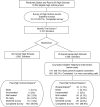Group-randomized trial of a proactive, personalized telephone counseling intervention for adolescent smoking cessation
- PMID: 19822836
- PMCID: PMC2765261
- DOI: 10.1093/jnci/djp317
Group-randomized trial of a proactive, personalized telephone counseling intervention for adolescent smoking cessation
Abstract
Background: The Hutchinson Study of High School Smoking randomized trial was designed to rigorously evaluate a proactive, personalized telephone counseling intervention for adolescent smoking cessation.
Methods: Fifty randomly selected Washington State high schools were randomized to the experimental or control condition. High school junior smokers were proactively identified (N = 2151). Trained counselors delivered the motivational interviewing plus cognitive behavioral skills training telephone intervention to smokers in experimental schools during their senior year of high school. Participants were followed up, with 88.8% participation, to outcome ascertainment more than 1 year after random assignment. The main outcome was 6-months prolonged abstinence from smoking. All statistical tests were two-sided.
Results: The intervention increased the percentage who achieved 6-month prolonged smoking abstinence among all smokers (21.8% in the experimental condition vs 17.7% in the control condition, difference = 4.0%, 95% confidence interval [CI] = -0.2 to 8.1, P = .06) and in particular among daily smokers (10.1% vs 5.9%, difference = 4.1%, 95% CI = 0.8 to 7.1, P = .02). There was also generally strong evidence of intervention impact for 3-month, 1-month, and 7-day abstinence and duration since last cigarette (P = .09, .015, .01, and .03, respectively). The intervention effect was strongest among male daily smokers and among female less-than-daily smokers.
Conclusions: Proactive identification and recruitment of adolescents via public high schools can produce a high level of intervention reach; a personalized motivational interviewing plus cognitive behavioral skills training counseling intervention delivered by counselor-initiated telephone calls is effective in increasing teen smoking cessation; and both daily and less-than-daily teen smokers participate in and benefit from telephone-based smoking cessation intervention.
Figures

Comment in
-
Helping adolescent smokers quit: can telephone quitlines lead the way?J Natl Cancer Inst. 2009 Oct 21;101(20):1367-8. doi: 10.1093/jnci/djp333. Epub 2009 Oct 12. J Natl Cancer Inst. 2009. PMID: 19822835 No abstract available.
References
-
- Centers for Disease Control and Prevention (CDC) Youth risk behavior surveillance–United States, 2007. MMWR Morb Mortal Wkly Rep. 2008;57(SS-4):11–14. 37–38, 61–66. - PubMed
-
- U.S. Department of Health and Human Services. With Understanding and Improving Health and Objectives for Improving Health. 2 vols. 2nd ed. 27. 2B. Washington, DC: U.S. Government Printing Office; 2000. Healthy people, 2010. (27)3–40.
-
- Chassin L, Presson CC, Pitts SC, Sherman SJ. The natural history of cigarette smoking from adolescence to adulthood in a midwestern community sample: multiple trajectories and their psychosocial correlates. Health Psychol. 2000;19(3):223–231. - PubMed
-
- Holmen TL, Barrett-Connor E, Holmen J, Bjermer L. Adolescent occasional smokers, a target group for smoking cessation? The Nord-Trøndelag Health Study, Norway, 1995-1997. Prev Med. 2000;31(6):682–690. - PubMed
-
- Baranowski T, Cullen KW, Basen-Engquist K, et al. Transitions out of high school: time of increased cancer risk? [review] Prev Med. 1997;26(5, pt 1):694–703. - PubMed

